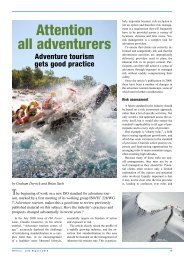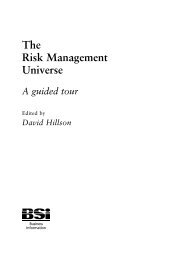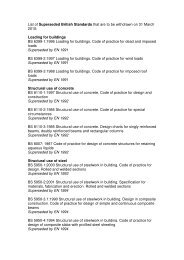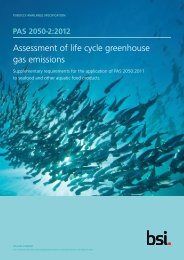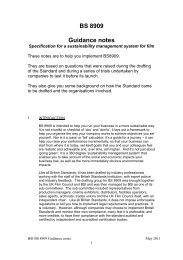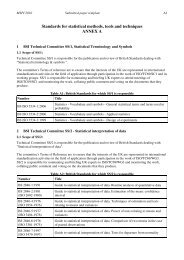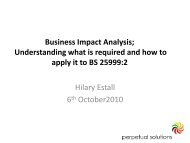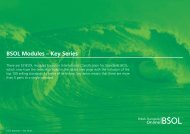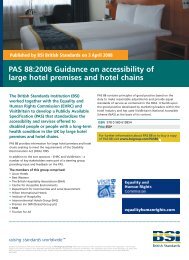Contents - BSI Shop
Contents - BSI Shop
Contents - BSI Shop
Create successful ePaper yourself
Turn your PDF publications into a flip-book with our unique Google optimized e-Paper software.
Acknowledgements<br />
PrefAce<br />
PArt one IntroductIon<br />
PArt two country InformAtIon<br />
European Union countries<br />
Non-EU countries<br />
China, People’s Republic of<br />
India<br />
Israel<br />
Norway<br />
South Africa<br />
South Korea<br />
Switzerland<br />
<strong>Contents</strong><br />
United States of America<br />
European Commission Correspondents Guideline on Shipments of Waste Electrical<br />
and Electronic Equipment (WEEE).<br />
Transboundary shipment of waste electrical and electronic equipment in the countries<br />
of destination.<br />
Nigeria, Ghana, South Africa, Philippines, Vietnam<br />
PArt three ImPlementAtIon In the unIted kIngdom<br />
APPendIces<br />
BIBlIogrAPhy<br />
<strong>BSI</strong> September 2011<br />
v
The WEEE Directive<br />
3. UK Regulations<br />
3.1 The implementation process<br />
In common with a number of other EU Member States, the UK missed the WEEE Directive’s implementation<br />
deadline of 13 August 2004. Extensive consultation was carried out, with four public consultations<br />
in August 2001, March 2003, July 2004 and July 2006. More than 1,000 responses were received. A<br />
separate consultation on environment agencies’ fees for producer registration took place in May 2005,<br />
and the agencies also consulted on guidance for treatment of WEEE.<br />
The WEEE Directive is implemented in the UK by the Waste Electrical and Electronic Equipment<br />
Regulations 2006 (SI No. 3289) (WEEE Regulations), as amended. The WEEE Regulations were laid before<br />
Parliament on 12 December 2006 and came into force on 2 January 2007. They implement the producer<br />
responsibility aspects of the WEEE Directive, with full implementation from 1 July 2007. The Regulations<br />
have been amended by the WEEE (Amendment) Regulations 2007 (SI No. 3454), the WEEE (Amendment)<br />
Regulations 2009 (SI No. 2957) and the WEEE (Amendment)(No.2) Regulations 2009 (SI No. 3216).<br />
Separate Regulations for England and Wales, Scotland and Northern Ireland transpose the treatment<br />
and permitting requirements of Article 6 of the WEEE Directive. In England and Wales, these were<br />
initially the Waste Electrical and Electronic Equipment (Waste Management Licensing) (England and<br />
Wales) Regulations 2006 (SI No.3315) (WEEE Licensing Regulations, as amended). They were laid<br />
before Parliament on 15 December 2006 and came into force on 5 January 2007. Similar legislation<br />
for Northern Ireland, the WEEE (Waste Management Licensing) (Northern Ireland) Regulations 2006<br />
(SI No. 519), also came into force on 5 January 2007, while the Waste Management Licensing<br />
Amendment (Waste Electrical and Electronic Equipment) (Scotland) Regulations 2007 (SI No. 172) came<br />
into force on 30 March 2007. The WEEE Licensing Regulations have been replaced by the Environmental<br />
Permitting (England and Wales) Regulations 2007 (SI No. 3538) (EP Regulations) which came into force<br />
on 6 April 2008. These simplify and streamline the permitting process for the pollution prevention<br />
and control regime and waste management licensing in England and Wales by introducing standard<br />
rules and standard permits. The government plans to extend the EP Regulations to other environmental<br />
permitting regimes in due course.<br />
The WEEE Regulations and treatment permitting legislation are supported by the following guidance:<br />
• WEEE Regulations 2006: Government Guidance Notes, BIS, November 2009, URN09/1446 13<br />
• Guidance on Best Available Treatment, Recovery and Recycling Techniques and Treatment of WEEE,<br />
DEFRA, November 2006 14<br />
• Code of Practice for Collection of WEEE from DCFs, DTI, February 2007, URN 07/657 15<br />
• Environmental Permitting Guidance: Waste Electrical and Electronic Equipment Directive, DEFRA,<br />
March 2008 16<br />
• Environmental Permitting Core Guidance, DEFRA, V2.0, November 2009 17<br />
13<br />
www.berr.gov.uk/files/file54145.pdf<br />
14<br />
www.defra.gov.uk/environment/waste/producer/electrical/documents/weee-batrrt-guidance.pdf<br />
15<br />
www.berr.gov.uk/files/file37922.pdf<br />
16<br />
www.defra.gov.uk/environment/policy/permits/documents/weee-directive.pdf<br />
17<br />
www.defra.gov.uk/environment/policy/permits/documents/ep-core-guidance.pdf<br />
12<br />
<strong>BSI</strong> February 2010
• SR2008 No.23: 5kte: WEEE ATF excluding ozone-depleting substances 18<br />
• SR2008 No.23: 25kte: WEEE ATF excluding ozone-depleting substances 19<br />
• SR2008 No.23: 75kte: WEEE ATF excluding ozone-depleting substances 20<br />
RoHS Regulations<br />
Implementation in the United Kingdom<br />
The RoHS Directive 2002/95/EU (RoHS-I, see Appendix 1 pp. A117) has been recast as Directive<br />
2011/65/EU (RoHS-II, see Appendix I, p. A I.27 which must be transposed into UK law by<br />
2 January 2013. It is expected that BIS will publish new regulations and guidance to implement the<br />
recast Directive in October/November 2012.<br />
RoHS-I was originally implemented by the RoHS Regulations 2006 (SI No. 1463) which came<br />
into force on 1 July 2006. These were replaced by the RoHS Regulations 2008 (SI No. 37) which<br />
came into force on 1 February 2008. These in turn will be replaced on 2 January 2013 when new<br />
regulations to implement RoHS-II come into force.<br />
The 2008 Regulations restrict the following substances in light bulbs, household luminaires and<br />
EEE categories 1 to 7 and 10: 21<br />
• lead;<br />
• mercury;<br />
• cadmium;<br />
• hexavalent chromium;<br />
• polybrominated biphenyls (PBBs);<br />
• polybrominated diphenyl ethers (PBDEs).<br />
The Regulations are enforced by the National Measurement Office (NMO). They apply directly to producers,<br />
rebranders, importers and exporters, and indirectly to parts and components manufacturers (see Clause 4).<br />
The RoHS Regulations are supported by the following guidance:<br />
• RoHS Regulations: Government Guidance Notes, BIS, February 2011, URN 11/526 22<br />
3.2 Implementation timetable<br />
Timetable for WEEE implementation:<br />
2 January 2007 WEEE Regulations 2006 in force<br />
5 January 2007 WEEE Licensing Regulations in force in England and Wales, and Northern Ireland<br />
28 February 2007 environment agencies publish first list of approved PCSs<br />
18 www.environment-agency.gov.uk/static/documents/Business/sr2008no23_5kte.pdf<br />
19 www.environment-agency.gov.uk/static/documents/Business/sr2008no23_25kte.pdf<br />
20 www.environment-agency.gov.uk/static/documents/Business/sr2008no23_75kte.pdf<br />
21 The 2002 RoHS Directive did not apply to EEE categories 8 and 9. This will change following the recast of<br />
the RoHS Directive 2011/65/EU (see Introduction section 3 The RoHS Directives and Appendix I, p A I.27<br />
DIRECTIVE 2011/65/EU ).<br />
22 www.bis.gov.uk/assets/biscore/business-sectors/docs/r/11-526-rohs-regulations-government-guidance-notes.pdf<br />
<strong>BSI</strong> September 2011<br />
13
Austria<br />
The objectives of waste management in Austria follow the generally accepted guiding principle of<br />
sustainable development that combines environmental, economic and social aspects. The Waste<br />
Management Act 2002 (Abfallwirtschaftsgesetz, (AWG)) provides Austria with a solid framework for the<br />
future development of waste management legislation, thus encouraging continued progress towards<br />
sustainable development.<br />
1. General requirements for producers<br />
Austrian EEE producers are required to:<br />
• register with the Federal Environment Agency (Umweltbundesamt (UBA));<br />
• set up at least one free of charge collection centre in each of Austria’s 99 political districts;<br />
• take back WEEE from retailers, consumers and local authorities;<br />
• take part in a collective system to collect and recover historical WEEE (i.e. WEEE placed on the<br />
market before 13 August 2005);<br />
• provide financial guarantees for the waste management of EEE placed on the market;<br />
• complete an agreement with the coordinating body covering collection infrastructure and public<br />
information.<br />
2. Legislation: the implementation process<br />
The WEEE Directive has been transposed into Austrian law through:<br />
• an amendment to the AWG which was approved by the Parliament on 20 December 2004 and<br />
came into force on 1 January 2005;<br />
• an Electro Ordinance (EAG-Verordnung) which was adopted on 18 April 2005 and covers all<br />
10 product categories in the WEEE Directive. The Electro Ordinance superseded the Lamp Ordinance<br />
and the Cooling Equipment Ordinance on 13 August 2005;<br />
• Ordinance on Waste Treatment Obligations (Abfallbehandlungspflichtenverordnung), published on<br />
3 December 2004 (see Notes, section 7).<br />
A visible fee for household equipment is allowed until 2011. The costs of collection and treatment<br />
of WEEE from private households put on the market as new products before 13 August 2005 may be<br />
displayed separately.<br />
<strong>BSI</strong> February 2011<br />
1
The WEEE Directive<br />
Business to business requirements<br />
Producers who put EEE on the commercial market before 13 August 2005 shall take back these products<br />
free of charge if they replace them with new products fulfilling the same function. Producers putting EEE<br />
on the commercial market after 12 August 2005 shall take back these products free of charge.<br />
With regard to WEEE from commercial operations, producers may agree with users of the equipment<br />
on arrangements for financing collection or treatment which differ from Paragraphs 1 and 2 (Article 10<br />
of the Electro Ordinance); contact the Federal Environment Agency (Umweltbundesamt (UBA)) for<br />
further details.<br />
Producers putting EEE on the market after 12 August 2005 shall permanently mark it and ensure the<br />
marking is highly visible and legible.<br />
3. Organizations responsible for implementation<br />
The UBA is the body responsible for producer registration:<br />
Umweltbundesamt<br />
Spittelaur Lände 5<br />
1090 Vienna<br />
Austria<br />
Tel: +43 1 31 304 5000<br />
E-mail: abfall@umweltbundesamt.at<br />
Website: www.umweltbundesamt.at<br />
Website for registration: http://edm.gv.at<br />
The clearing house (Elektroaltgeräte Koordinierungsstelle) is managed by the Austrian Chamber of<br />
Commerce (Wirtschaftkammer Österreich). New organizations must register no more than one month<br />
after they start operations.<br />
The duties of the clearing house include making agreements with and coordinating collection<br />
and treatment systems. This includes the financing of the collection infrastructure and provision of<br />
information to end-users.<br />
Producers or their compliance systems must pick up collected WEEE no more than one week<br />
after being notified and after defined minimum quantities have been collected. If they fail to do so the<br />
clearing house will organize collection and treatment and pass on the cost to the compliance systems or<br />
individual producers.<br />
Elektroaltgeräte Koordinierungsstelle Austria GmbH<br />
Mariahilfer Str. 84/6.06<br />
1070 Vienna<br />
Austria<br />
Tel: +43 1 52 237 6210<br />
Fax: +43 1 52 237 6219<br />
Website: www.eak-austria.at<br />
2<br />
<strong>BSI</strong> February 2011
4. Permits, registration fees, reporting and penalties<br />
<strong>BSI</strong> February 2011<br />
Austria<br />
The UBA is responsible for producer registration. Producers and importers of B2C and B2B EEE (including<br />
distance sellers) have been required to register since 30 September 2005. The registration is free of<br />
charge. Producers starting to place EEE on the market after that must register within one month of starting<br />
operations. Since 31 October 2005 producers have been obliged to report on the amount of EEE placed<br />
on the market.<br />
In Austria five companies have the permission to act as a collective collection and recovery system:<br />
EVA Erfassen und Verwerten von Altstoffen GmbH Ungargasse 35 3<br />
AT 1030, Wien<br />
w.kleer@eva.co.at<br />
ERA Elektro Recycling Austria GmbH Mariahilferstraße 123<br />
AT 1060, Wien<br />
dostal@era-gmbh.at<br />
European Recycling Platform (ERP) Österreich GmbH Döblinger Hauptstr. 50<br />
AT 1190, Wien<br />
Tel.: +43 0<br />
sabine.hadl@erp-recycling.org<br />
UFH Altlampen Systembetreiber GmbH Mariahilfer Straße 37-39<br />
AT 1060, Wien<br />
brigitte.reich@ufh.at<br />
UFH Elektroaltgeräte System Betreiber GmbH Mariahilfer Straße 37-39<br />
AT 1060, Wien<br />
brigitte.reich@ufh.at<br />
5. Recycling/reuse/recovery organizations: contact details<br />
Registered collection and treatment organizations (Registerabfrage, EAG-Behandler)<br />
Name Address Telephone Devices<br />
Abfallwirtschaftsverband<br />
Feldbach<br />
AVE Beteiligungsverwaltungs<br />
GmbH+CoKG<br />
ÖKO-Platz 1<br />
8330 Mühldorf bei<br />
Feldbach<br />
Flughafenstraße 8<br />
4063 Hörsching<br />
+43 724 27<br />
1475-127<br />
Television sets; small<br />
electrical devices<br />
Television sets; large electrical<br />
equipment; small electrical<br />
devices; cooling and freezing<br />
devices; gas-discharge lamps<br />
3



